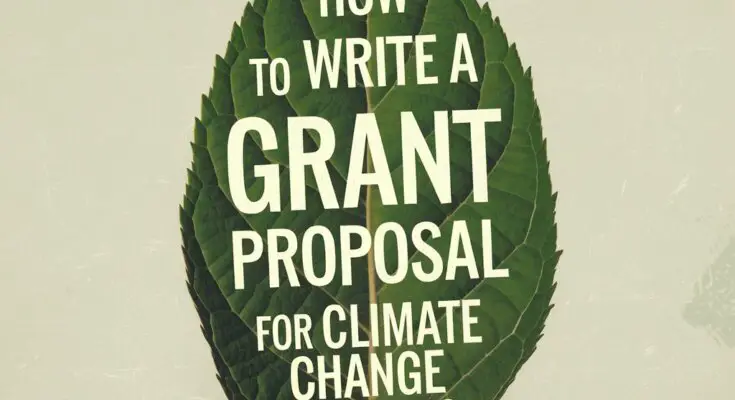Writing a grant proposal for climate change projects can feel like a daunting task, especially with the urgency of climate issues at the forefront of our global concerns.
However, with the right guidance and understanding of the process, you can craft a compelling proposal that effectively communicates your project’s goals and significance.
This guide will walk you through the essential elements of a successful grant proposal tailored for climate change initiatives, providing practical examples and insights that any nonprofit can apply.
Let’s embark on this journey to secure funding for your important work!
Understanding the Purpose of a Grant Proposal
At its core, a grant proposal is a formal request for funding. It outlines your project’s objectives, methods, and expected outcomes, demonstrating to potential funders why your project deserves support.
For climate change projects, your proposal should highlight the urgency of the issue and how your project contributes to meaningful change.
The Components of a Grant Proposal
A typical grant proposal includes several key components:
- Executive Summary
- Problem Statement
- Objectives
- Project Design and Implementation
- Budget
- Evaluation Plan
- Conclusion
Let’s explore each of these components in detail, focusing on how you can effectively address climate change in your proposal.
1. Crafting an Engaging Executive Summary
The executive summary is the first thing funders will read, so it needs to be compelling. This section should provide a brief overview of your project, including:
- The problem you’re addressing.
- Your project’s goals and objectives.
- The impact you anticipate.
Example: “Our project aims to combat rising sea levels in Sunnyvale by implementing a community-based coastal restoration initiative. By engaging local residents and restoring natural habitats, we anticipate reducing flood risk and enhancing biodiversity in the area.”
To capture the reader’s attention, start with a powerful statement or statistic. For instance: “Did you know that over 13 million people in the U.S. are at risk of flooding due to rising sea levels? Our community is determined to change this statistic.”
2. Develop a Strong Problem Statement
The problem statement outlines the specific climate issue your project addresses. This section should convey the urgency and relevance of your project. To make it impactful:
- Use Data: Include recent statistics or studies to support your claims. Funders want to see that you’re informed and that your project is based on solid evidence.
- Tell a Story: Personalize the problem by sharing a real-life example. This helps funders connect emotionally with your cause.
Example: “In Sunnyvale, increased flooding has displaced families and damaged homes. Maria, a local resident, lost her house in last year’s flood. Like many others, she is searching for a solution. By addressing coastal erosion through our restoration project, we aim to prevent further tragedies like hers.”
3. Set Clear Objectives
Once you’ve established the problem, it’s time to outline your project’s objectives. These should be SMART: Specific, Measurable, Achievable, Relevant, and Time-bound.
How to Write Objectives
- Specific: What exactly do you want to achieve?
- Measurable: How will you measure success?
- Achievable: Is your goal realistic given your resources?
- Relevant: How does your objective relate to the broader climate issue?
- Time-bound: When do you expect to achieve this?
Example: “Our objective is to restore 5 acres of coastal habitat within 18 months, which will reduce flooding by 20% in the targeted area. We will measure success by monitoring changes in water levels and community engagement.”
4. Design a Comprehensive Project Plan
In this section, outline the specifics of your project design. This includes your methodology, timeline, and team. Funders want to see a clear and practical plan that demonstrates how you’ll achieve your objectives.
Key Components of Your Project Plan
- Methods: Detail the strategies you will use. For example, will you involve community volunteers, partner with local businesses, or leverage existing research?
- Timeline: Create a timeline that outlines major milestones and deadlines. This helps funders understand your project’s scope and duration.
- Team: Highlight the qualifications of your team members. Describe their expertise and how they contribute to the project’s success.
Example: “Our project will follow a three-phase approach:
- Phase 1 (Months 1-6): Community outreach and education.
- Phase 2 (Months 7-12): Habitat restoration activities.
- Phase 3 (Months 13-18): Monitoring and evaluation of project impacts.
Our team includes environmental scientists, community organizers, and volunteers committed to making a difference.”
5. Budget Your Project Effectively
A well-prepared budget is crucial for your grant proposal. Funders need to understand how their money will be spent.
Tips for Creating a Budget
- Itemize Costs: Break down your budget into clear line items, such as personnel, materials, and administrative costs.
- Justify Expenses: Provide explanations for each line item, demonstrating why they are necessary for project success.
- Be Realistic: Ensure your budget is grounded in reality and reflects actual costs.
Example: “Our total project budget is $100,000, which includes:
- $40,000 for personnel (salaries for project staff),
- $30,000 for materials (plants, tools, and equipment),
- $20,000 for outreach and education,
- $10,000 for administrative costs.”
6. Evaluate Your Project’s Impact
Funders want to know how you’ll assess the effectiveness of your project. An evaluation plan outlines how you’ll measure success, including both quantitative and qualitative metrics.
Components of an Evaluation Plan
- Metrics: Identify specific metrics that will demonstrate the impact of your project. For climate change projects, this could include reductions in carbon emissions, improvements in biodiversity, or community engagement levels.
- Methods: Describe how you’ll collect and analyze data. Will you conduct surveys, interviews, or use existing research?
- Feedback Loop: Highlight how you’ll use evaluation findings to improve future efforts.
Example: “We will evaluate our project’s success by:
- Measuring the area of restored habitat (quantitative),
- Conducting community surveys to assess awareness and engagement (qualitative),
- Reporting results to funders and stakeholders to improve future initiatives.”
7. Writing a Compelling Narrative
While data is important, a well-crafted narrative can make your proposal stand out. A compelling story engages readers and helps them connect emotionally with your cause.
Tips for Crafting Your Narrative
- Be Personal: Use anecdotes to illustrate the impact of your project. This humanizes the issue and makes it relatable.
- Visualize Your Impact: Paint a picture of the future. What will the community look like after your project is implemented?
Example:
Let’s revisit Maria, the resident who lost her home to flooding. Thanks to our coastal restoration project, she was able to participate in volunteer days to plant new vegetation along the shore.
As a result, not only did she regain her sense of community, but she also became an advocate for climate action. Today, Maria shares her story at local events, inspiring others to take part in the fight against climate change.
This personal connection highlights the real-world impact of your project and reinforces its importance.
8. Tailoring Your Proposal to the Funder
Every funder has specific priorities and interests. Tailoring your proposal to align with their mission is essential for success.
How to Tailor Your Proposal
- Research the Funder: Understand their goals, values, and past funding history. What types of projects do they support?
- Use Their Language: Incorporate the funder’s terminology and priorities into your proposal.
- Demonstrate Fit: Clearly explain how your project aligns with the funder’s objectives and mission.
Example: If you’re applying to a funder focused on sustainable practices, emphasize how your project incorporates renewable resources and promotes environmental stewardship.
9. Reviewing and Editing Your Proposal
Once your proposal is complete, take the time to review and edit it thoroughly. A polished proposal demonstrates professionalism and attention to detail.
Tips for Effective Editing
- Read Aloud: Hearing your words can help identify awkward phrasing or unclear ideas.
- Seek Feedback: Have colleagues or mentors review your proposal. Fresh eyes can catch errors and suggest improvements.
- Check for Consistency: Ensure that your formatting, style, and tone are consistent throughout the document.
Conclusion
Writing a successful grant proposal for climate change projects requires careful planning, clear communication, and a compelling narrative. By following the strategies outlined in this guide, you can increase your chances of securing funding for your important work.
Remember, the fight against climate change is urgent, and every project counts. Your proposal can be a crucial step in driving positive change in your community.
For more expert tips, resources, job opportunities, grant opportunities, exclusive webinars, and events, subscribe to the Nonprofit Navigators Newsletter. Let’s work together to navigate the nonprofit landscape and create lasting change for our planet!
Call to Action
Don’t miss out on valuable insights and opportunities—subscribe to the Nonprofit Navigators Newsletter today! Together, we can make a difference in the fight against climate change and empower our communities to thrive.




